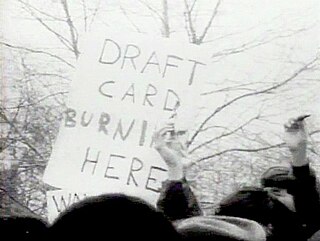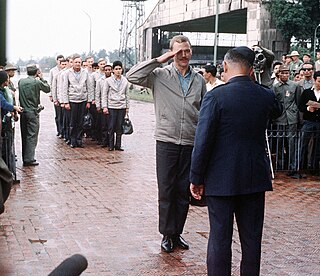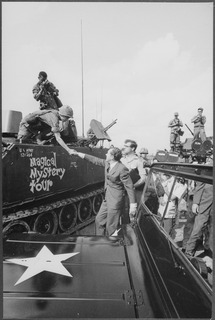 W
WAt the end of World War II in Asia, France attempted to regain control of Vietnam, as part of French Indochina, which it had lost to Japan in 1941. Following the First Indochina War, the country was split into two parts, the North and the South. The southern part was named the State of Vietnam under the leadership of Bảo Đại. In 1950, the United States recognized the Bảo Đại government, established diplomatic relations, and sent its first ambassador to Saigon in South Vietnam, officially known as the Republic of Vietnam following the rise of Ngô Đình Diệm in 1955. The US was opposed to the communist government of the North, led by Hồ Chí Minh, and did not recognize the northern regime.
 W
WDraft-card burning was a symbol of protest performed by thousands of young men in the United States and Australia in the 1960s and early 1970s. The first draft-card burners were American men taking part in the opposition to United States involvement in the Vietnam War. The first well-publicized protest was in December 1963, with a 22-year old conscientious objector, Eugene Keyes, setting fire to his card on Christmas Day in Champaign, Illinois. In May 1964, a larger demonstration, with about 50 people in Union Square, New York, was organized by the War Resisters League chaired by David McReynolds.
 W
WThe Gulf of Tonkin Resolution or the Southeast Asia Resolution, Pub.L. 88–408, 78 Stat. 384, enacted August 10, 1964, was a joint resolution that the United States Congress passed on August 7, 1964, in response to the Gulf of Tonkin incident.
 W
WThe March on the Pentagon was a massive demonstration against the Vietnam War in 1967. The protest would involve more than 100,000 attendees at a rally by the Lincoln Memorial, later about 50,000 people would march across the city to The Pentagon and spark a confrontation with paratroopers on guard. The demonstration would be highly polarizing, and also produce the famous photograph of a protester placing flowers in a paratroopers' rifle.
 W
WThe Moratorium to End the War in Vietnam was a massive demonstration and teach-in across the United States against the United States involvement in the Vietnam War. It took place on October 15, 1969, followed a month later, on November 15, 1969, by a large Moratorium March in Washington, D.C.
 W
WOperation Homecoming was the return of 591 American prisoners of war (POWs) held by North Vietnam following the Paris Peace Accords that ended U.S. involvement in the Vietnam War.
 W
WVietnamization was a policy of the Richard Nixon administration to end U.S. involvement in the Vietnam War through a program to "expand, equip, and train South Vietnamese forces and assign to them an ever-increasing combat role, at the same time steadily reducing the number of U.S. combat troops". Brought on by the Viet Cong's Tet Offensive, the policy referred to U.S. combat troops specifically in the ground combat role, but did not reject combat by the U.S. Air Force, as well as the support to South Vietnam, consistent with the policies of U.S. foreign military assistance organizations. U.S. citizens' mistrust of their government that had begun after the offensive worsened with the release of news about U.S. soldiers massacring civilians at My Lai (1968), the invasion of Cambodia (1970), and the leaking of the Pentagon Papers (1971).